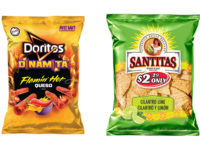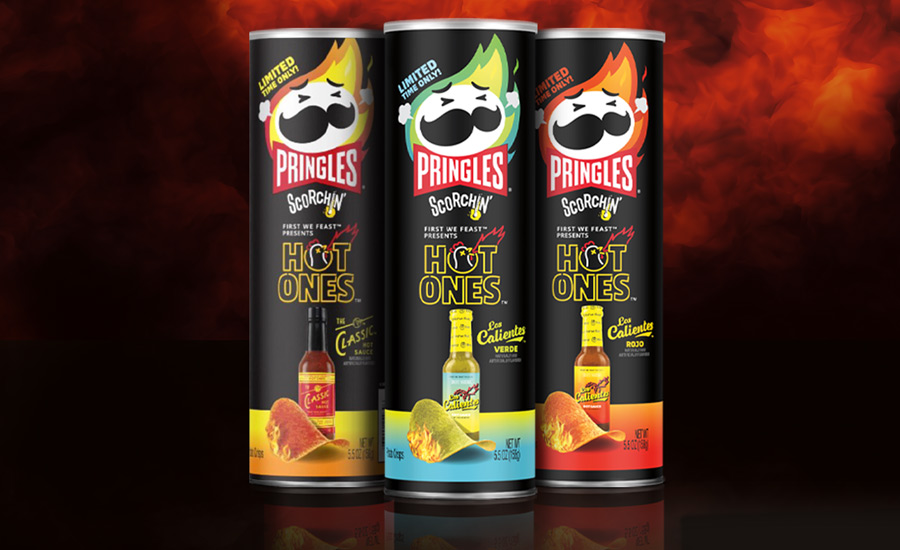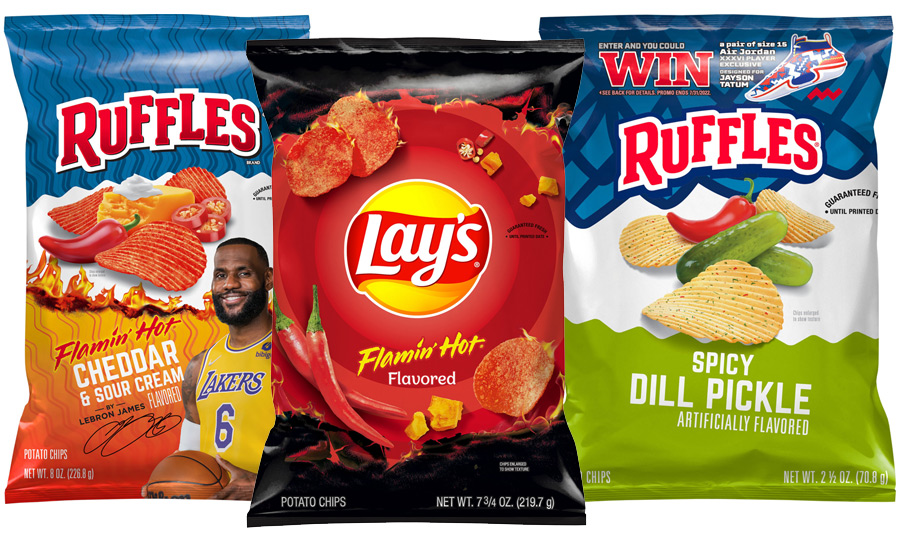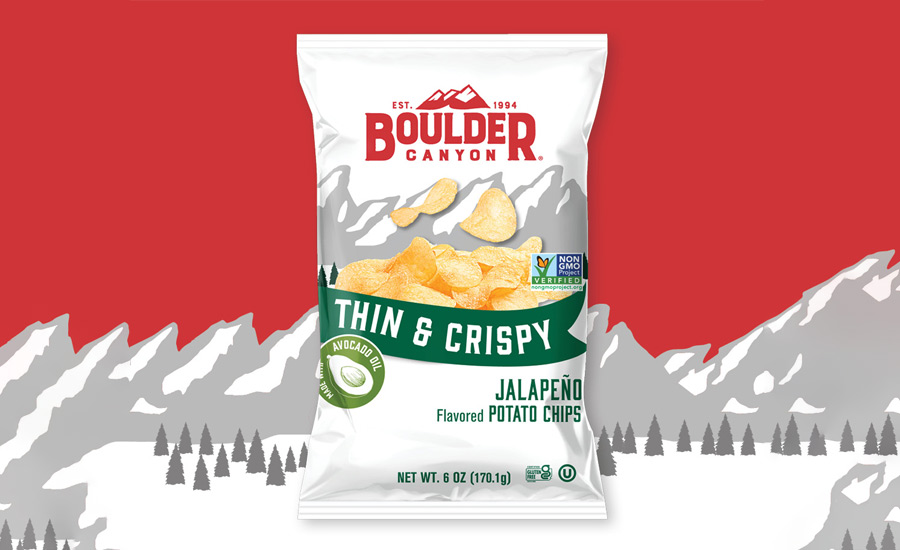State of the Industry 2022: Chips continue to reign supreme
Although COVID-19 changed the snacking landscape, chips continue to resonate with consumers.

Courtesy of Kellogg Co.

Courtesy of Frito-Lay

Courtesy of Utz Quality Foods



All that and a bag of chips: You don’t have to be an Urban Dictionary editor to know that the phrase suggests something’s pretty special. And given the continued dynamism in today’s chips space, it’s apparent that snack chips—from retro potato platforms to better-for-you fruit and grain options—are something special, indeed. One could even argue they’re “all that” and a whole lot more.
But to twist the metaphor a bit further, it’s also true that disruptions to daily life over the past few years have made the pandemic era something of a … mixed bag for the snack-chips category, as snacking weathered the same storms as did every other habit consumers were accustomed to.
But with life—and snacking—returning to normal, consumers are proving with their snack spend that even when the chips are down, you just can’t hold a solid snack back. And judging by both sales data and insider anecdote alike, the state of the snack-chip market is solid as a rock.
Market data
Historians will be studying COVID-19’s effects for years, but one thing’s clear right now: “Snacking frequency definitely increased throughout the pandemic,” declares Dan DeMeyer, director, sales strategy, Kellogg Co., Battle Creek, MI.
Moreover, he continues, “The salty category continued to see growth, with chips, in particular, always a salty-snack favorite.”
The numbers bear him out: Tallies from IRI, Chicago, show sales of potato chips topping the salty-snacks category overall, at a whopping $8.9 billion as of April 17, 2022—accounting for more than a third of the salty-snacks category’s total sales of $31.5 billion. That $8.9 billion represents an increase of 6.2% over the preceding 52 weeks.
And increasing sales proved a theme even for individual brands within the potato-chips category, many of which saw growth rates ranging from a mere 0.3% for Zapp’s (an Utz Quality Food brand)—bringing sales to $59.5 million—and 1.3% for Kettle Brand (Campbell Snacks) for a sales total of $269.8 million, to as much as 120.9% growth for Barcel (Grupo Bimbo), which clocked in at sales of $62.3 million, and 43.2% growth for Deep River Snacks, which, although a smaller player in the space, still registered sales of $24.7 million for the year.
At Frito-Lay, its Lay’s brand led the pack with sales of $3.6 billion on growth of 3.9%, while Ruffles ($1.6 billion on growth of 13.2%) followed close behind.
The Kellogg Co. Pringles brand also saw strong growth, up to $1.2 billion on growth of 16.2%.
The apple chips category in its entirety accounted for $10.4 million in sales over the 52 weeks ending April 17, per IRI. But those modest sales still represent 21.2% growth, a continuing trend for the better-for-you segment. Cases in point: Leading brand Bare grew sales 38.4% to $7.1 million, while second-place Seneca racked up $2.6 million in sales and 13.5% growth. Greenetown Foods and Martin’s—the respective third- and fourth-place brands in the apple chip category—both broke the six-figure barrier while experiencing impressive growth, to boot. In fact, Greentown generated $420,646 in sales on growth of 33.6%, and Martin’s brought home $170,447 on growth of 30.2%.
Looking back
We continue to see that COVID-19 has become the dominant theme of the age, and no snack category will emerge unscathed.
Even Kellogg’s iconic Pringles brand saw its prospects thrown for a bit of a loop, DeMeyer concedes, as the chips’ “perfect for grab-and-go” reputation lost some of its savor once widespread shelter-in-place orders kept snackers safe at home.
But the flipside to less out-and-about snacking was more snacking inside, DeMeyer continues, “and that seems to have developed into a habit, too, as snacking trends have been at all-time highs even over the past year.”
He cites data showing that convenience inside sales excluding gas were up 8.2% from 2021 versus 2020, and 14.2% from 2021 versus 2019. “And the at-home trend will likely continue with rapid inflation,” he wagers, “as consumers look to spend less on out-of-home dining and increase their spending on groceries.”
Even so, the world’s got to reopen at some point—and as it does, on-the-go will find itself front-and-center once again, supplementing those at-home snacking occasions with more opportunities to crunch on the run.
DeMeyer’s can already sense the wanderlust. “Presently, grab-and-go is seeing a comeback with summer travel and consumers returning to normalcy,” he observes. “And Pringles is seeing even higher growth because of these recent consumer trends. In fact, trends are up even stronger versus 2019, at more than 40% growth for the brand.”
A return to normalcy means that snack-chip formulators can return to focusing on the future with forward-looking innovations, including flavor profiles.
In the past year, Frito-Lay released spicy and sporty new products, including partnerships with Jayson Tatum, three-time NBA All-Star and NBA Eastern Conference Finals MVP. Tatum helped introduce Ruffles’ newest flavor, Spicy Dill Pickle, in June.
Basketball icon LeBron James also introduced another addition to Lay’s’ Flamin’ Hot family: Ruffles Flamin’ Hot Cheddar & Sour Cream Flavored Potato Chips.
In addition, last year Lay’s changed the Lay’s Flamin’ Hot formula and fans made it loud and clear they wanted the original recipe back—so now Lay’s Flamin’ Hot original formula chips are back on shelves nationwide.
Utz Quality Foods added some spice to its lineup through its Boulder Canyon brand and its new Thin & Crispy Jalapeño flavored Potato Chips, a thinner-cut chip cooked in avocado oil. The brand also partnered with New England pickle brand Grillo’s Pickles to create Utz Dill Pickle flavored potato chips.
Looking forward
“The salty category has seen a trend toward extreme heat,” says DeMeyer.
That’s certainly the direction Pringles has pursued—and found success with, DeMeyer adds, as the brand’s aptly named Scorchin’ platform “continues gaining popularity and showing strong growth.” The brand even recently announced a partnership with Emmy-nominated talk show “Hot Ones,” ushering in the release of three new spicy flavors for summer.
To start, the Scorchin’ Hot Ones Los Calientes Rojo flavor creates what DeMeyer describes as “a fiery blaze” courtesy of “the perfect balance of sweet-applewood-smoked red jalapeños and tangy habanero.” He advises looking for the SKUs at Walmart locations starting in June. Meanwhile, the line’s Los Calientes Verde variety—also set to roll out beginning in June to retailers nationwide—is a “punchy, smoky blend of serrano and habanero chiles, sweet fruit and tart tomato,” DeMeyer explains. And finally, the limited-edition The Classic Hot Sauce profile combines the “timeless” flavor of hot sauce with “an extra peppery kick,” according to DeMeyer, and will be available at Circle K beginning in July “while supplies last.”
“We’re especially proud of this partnership because it perfectly combines pop-culture and social-media trends while bringing consumers the bold flavors we know they’ll enjoy thoroughly,” DeMeyer concludes. “Based on our past success with other Pringles Scorchin’ SKUs”—including the line’s BBQ, Cheddar Cheese, Chili Lime, and Sour Cream and Onion profiles, all launched over the past two years—“we know customers will love the delicious, fiery burn these Pringles offer. We’re always cooking up something new and hope to continue bringing consumers bold flavors for years to come.”
In fact, they aim to do just that next year with the launch of a new Buffalo Chicken profile, adding to the Scorchin’ lineup.
By bringing a timely take on flavor to the classic chip platform, iconic brands like Pringles stay relevant in an evolving snack landscape. Turns out consumers like blending a bit of the old with the new.
As DeMeyer observes, “We’ve found that a lot of consumers keep returning to the classic brands they know and love, like Pringles. Even manufacturers are beginning to copy the iconic canister, as consumers perceive it as a great on-the-go item.”
And now that consumers have more places to go to, they’ll likely be buying more chips to take with them.
Source: IRI Market Advantage, Integrated Fresh, Total U.S. - Multi Outlet w/ C-Store (Grocery, Drug, Mass Market, Convenience, Military and Select Club & Dollar Retailers), 52 Weeks Ending 04-17-22
Looking for a reprint of this article?
From high-res PDFs to custom plaques, order your copy today!








